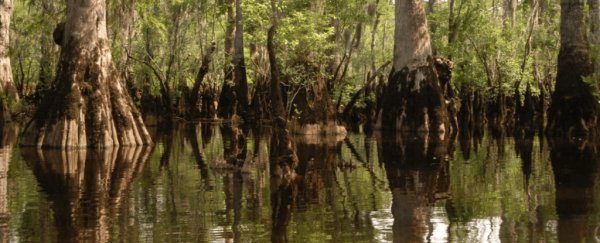Along the Black River in North Carolina, bald cypress trees have been quietly growing for millennia. Quite literally so: Scientists recently found trees over 2,000 years old - including one that is at least 2,624 years old.
That makes it the fifth-oldest known non-clonal tree in the world. (Utah's Pando, an ancient quaking aspen forest, reproduces asexually, by cloning itself from an 80,000-year-old root system.)
Another nearby tree was found to be 2,088 years old - and geoscientists believe that more bald cypresses (Taxodium distichum) in the Three Sisters Swamp could be the same age or even older.
"There are surely multiple over 2,000-year-old trees at Black River," geoscientist David Stahle of the University of Aransas told The Charlotte Observer.
"It's my belief there are some approaching, if not exceeding, 3,000 years old."
 The top 10 oldest known trees in the world. (The University of Arkansas)
The top 10 oldest known trees in the world. (The University of Arkansas)
It has been known for decades that some of the trees in the region are ancient. In the 1980s, Stahle and colleagues discovered trees up to 1,700 years old. This led to the private purchase of 16,000 acres by the North Carolina Nature Conservancy to help protect these stately plants.
But this new discovery significantly pushes back the known age of the trees by nearly a millennium.
It was made in an area of wetland not previously visited by the research team.
Using a sampling tool known as an increment borer that does no lasting harm to the trees, the researchers can take a core sample that allows them to count the tree's rings - the ones made by annual growth layers. These samples can be complicated by core rot, resulting in trees that are hollow in the middle, so the team selected trees that are solid all the way through.
Surprisingly, a tree named BLK227 was found to be at least 2,624 years old. That makes it a seedling or sapling in 605 BCE - a timeframe that predates the Roman Empire by centuries, and the year Nebuchadnezzar II ascended to the throne of Babylon.
Another tree, BLK232, was 2,088 years old - dating back to 70 BCE, around the time the great queen Cleopatra was born.
"It is exceedingly unusual to see an old-growth stand of trees along the whole length of a river like this," Stahle said. "Bald cypress are valuable for timber and they have been heavily logged. Way less than 1 percent of the original virgin bald cypress forests have survived."

These trees are not remarkable only for their age. The rings of bald cypress trees are a clear record of the rainfall during the growing season of any given year.
So the rings of BLK227 and BLK232 contain valuable information on two and a half millennia's worth of climate information - droughts and floods dating all the way back to the time of the Neo-Babylonian Empire.
Of particular interest was a severe drought that started in 1587 and lasted two years, coinciding with the first attempts to settle in Roanoke in North Carolina - possibly shedding some light on why the settlers of Roanoke Colony disappeared sometime between 1587 and 1590.
"It's an amazing coincidence that the oldest known living trees in eastern North America also have the strongest climate signal ever detected anywhere on Earth," Stahle told the Smithsonian.
"The best correlations we've ever seen are with these trees. Why that is I don't know. They're incredibly old and extremely sensitive to climate, especially rainfall."
The team has only cored 110 trees, out of tens of thousands, so it's not just possible, but likely that there are even older trees in the swamp. Some of them may be hollow, and therefore dating them may be impossible, but that doesn't make them any less incredible.
It makes protecting the region even more important. There's the aforementioned threat of logging, of course - but other human activities pose a more indirect threat. Pollution. Climate change. Rising sea levels.
"To counter these threats, the discovery of the oldest known living trees in eastern North America, which are in fact some of the oldest living trees on Earth, provides powerful incentive for private, state, and federal conservation of this remarkable waterway," the scientists wrote in their paper.
The research has been published in Environmental Research Communications.
